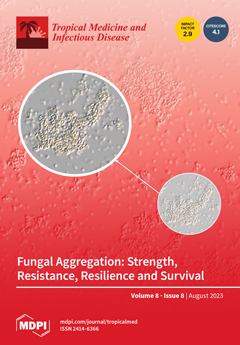Echinococcus spp. are important cosmopolitan zoonotic parasitic tapeworms that cause a disease called hydatidosis or cystic echinococcosis (CE), which has remarkable economic losses. The objective of our study was to develop a specific IgG polyclonal antigen-based ELISA (Sandwich ELISA; capture ELISA) method for the detection of circulating
Echinococcus granulosus (
E. granulosus) antigens in camels infected with hydatid cysts before slaughtering and its application in serodiagnosis of CE in animals to assess the positive rate of hydatidosis in camels slaughtered in Giza governorate abattoirs in Egypt. In this study, molecular identification of
Echinococcus sp. isolate was performed based on the NADH dehydrogenase subunit 1 (NAD1) gene, revealing the isolate (GenBank: OQ443068.1), which is identical to the G6
E. granulosus sensu lato genotype. The positive rate of hydatid cysts was determined in slaughtered camels’ organs (
n = 587). The results revealed that hydatid cysts were found in 46.5% (273/587) of the examined camels. Pulmonary echinococcosis was significantly more prevalent in the slaughtered camels (60%, 164/273) than hepatic echinococcosis (39.9%, 109/273), (
p = 0.001, Chi Square = 11.081). Cyst fertility rates were higher in hepatic (90.8%, 99/109) than in pulmonary cysts (83.5%, 137/164) and the most viable protoscoleces were recorded from fertile the hepatic cysts (67.85 ± 12.78). In this study, hydatid cyst germinal layer antigen (GlAg) was isolated and used for the immunization of rabbits to raise IgG polyclonal antibodies (anti-
Echinococcus GlAb IgG). These IgG polyclonal antibodies were purified by affinity chromatography using a protein A column, then labeled with horseradish peroxidase. Electrophoretic analysis of IgG polyclonal antibodies and crude GlAg was performed in 10% polyacrylamide gels. The SDS-PAGE revealed four bands at molecular weights of 77 kDa, 65 kDa, 55 kDa, and 25 kDa. The Sandwich ELISA was performed to evaluate the sensitivity and specificity and cross-reactivity of the prepared IgG polyclonal antibodies. The circulating hydatid antigen was found in 270 out of the 273 samples with hydatidosis, with a sensitivity of 98.9% (270/273), a specificity of 94.9% (296/312) and a diagnostic efficacy of 96.8%. Regarding the cross reactivity, anti-
Echinococcus GlAb IgG showed a low cross-reactivity with
Fasciola gigantica infected camel sera (3/8), and Myiasis (
Cephalopina titillator larvae; 3/20). No cross-reactivity was recorded with uninfected camel sera (negative sera for
E. granulosus), and no cross-reactivity was found with antigens of
Eimeria spp.,
Toxoplasma gondii,
Cryptosporidium sp., and
Hyalomma dromedarii (ticks’ infestation). Then, Sandwich ELISA was conducted again to detect
E. granulosus antigen in all the collected camel sera, which resulted in a 48.7% (286/587) positive rate of CE compared to 46.5% (273/587) using a postmortem inspection (PM diagnosis) (
p = 0.5, Chi Square = 0.302). In conclusion, the Sandwich ELISA technique introduced in this study appears to be a sufficiently sensitive diagnostic assay for the detection of camels’ echinococcosis using anti-
Echinococcus GlAb IgG. In addition, it might offer a significant medical and veterinary importance in helping the early detection of hydatidosis, as well as its early treatment.
Full article






